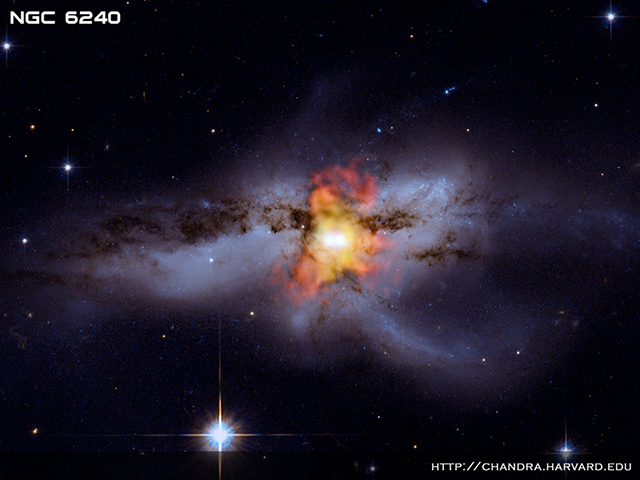Colliding Galaxies and Black Holes
Colliding Galaxies and Black Holes
Are their any colliding galaxies under obsevation where it is expected their centers will merge in our lifetime ?
What is the scientific expectation when two black holes merge/collide ?
What is the scientific expectation when two black holes merge/collide ?
- neufer
- Vacationer at Tralfamadore
- Posts: 18805
- Joined: Mon Jan 21, 2008 1:57 pm
- Location: Alexandria, Virginia
Re: Colliding Galaxies and Black Holes
How old are you astrobob?astrobob wrote:Are their any colliding galaxies under obsevation where it is expected their centers will merge in our lifetime ?
astrobob wrote:What is the scientific expectation when two black holes merge/collide ?
http://en.wikipedia.org/wiki/LIGO wrote:
<<In August 2002, the Laser Interferometer Gravitational-Wave Observatory (LIGO) began its search for cosmic gravitational waves. Measurable emissions of gravitational waves are expected from binary systems (collisions and coalescences of neutron stars or black holes), supernova of massive stars (which form neutron stars and black holes), rotations of neutron stars with deformed crusts, and the remnants of gravitational radiation created by the birth of the universe. The observatory may in theory also observe more exotic currently hypothetical phenomena, such as gravitational waves caused by oscillating cosmic strings or colliding domain walls. Since the early 1990s, physicists have believed that technology is at the point where detection of gravitational waves—of significant astrophysical interest—is possible.
http://www.black-holes.org/explore2.html
The LIGO Laboratory [is] building Advanced LIGO. This detector (formerly referred to as "LIGO 2") is designed to improve the sensitivity of Initial LIGO (LIGO 1) by more than a factor of 10. This new detector, which should be operational in 2014, will be installed at the LIGO Observatories to replace the present detector, and is anticipated to transform gravitational wave science into a real observational tool. It is anticipated that this new instrument will see gravitational wave sources possibly as often as daily, with excellent signal strengths, allowing details of the waveforms to be read off and compared with theories of neutron stars, black holes, and other highly relativistic objects. The improvement of sensitivity will allow the one-year planned observation time of initial LIGO to be equaled in just several hours. But when even one verified gravitational wave event is observed by any of the worldwide detectors, it will be a truly exciting moment for all astronomers and astrophysicists worldwide who have waited so long for such an event to be seen.>>
Art Neuendorffer
-
The Code
- 2+2=5
- Posts: 913
- Joined: Sat Mar 07, 2009 6:39 pm
- AKA: Swainy
- Location: The Earth, The Milky Way, Great Britain
When Giants Collide
What would happen if two giants collide?
Take all the matter/energy in the universe and share it out evenly to, two black holes... Each black hole is 400 billion solar masses or maybe more... What would be the out come?
Our universe perhaps?
http://content.zdnet.com/2346-9595_22-12779-3.html
Mark
Take all the matter/energy in the universe and share it out evenly to, two black holes... Each black hole is 400 billion solar masses or maybe more... What would be the out come?
Our universe perhaps?
http://content.zdnet.com/2346-9595_22-12779-3.html
Mark
Always trying to find the answers
When Black Holes Collide
What Happens When Supermassive Black Holes Collide?
Universe Today - February 29th, 2008
What Happens When Three Black Holes Collide?
Universe Today - April 9th, 2008
When Black Holes Collide
STScI Colloquium - February 18, 2009
Universe Today - February 29th, 2008
What Happens When Three Black Holes Collide?
Universe Today - April 9th, 2008
When Black Holes Collide
STScI Colloquium - February 18, 2009
Re: When Giants Collide
3C 75 in Abell 400: Black Holes Determined to be Boundmark swain wrote:http://content.zdnet.com/2346-9595_22-12779-3.html
NASA - Chandra X-ray Observatory - April 06, 2006
Simulation Breakthrough: When Black Holes Collide
PhysOrg - April 18th, 2006
Re: Colliding Galaxies and Black Holes
Thanks all.
To say we are in a golden age of astronomy is something of an understatement !
To say we are in a golden age of astronomy is something of an understatement !
HEAPOW: Darkness Dancing (2009 October 12)

Credit: X-ray (NASA/CXC/MIT); Optical (NASA/STScI)
HEAPOW: Darkness Dancing (2009 October 12)
NGC 6240: Black Holes Go "Mano A Mano"Supermassive black holes lie at the heart of most (if not all) galaxies. Sometimes these black holes are voracious, swallowing everything in their neighborhood, generating enormous beams of radiation. In other cases (like the central black hole in our own Milky Way) they lie quietly, waiting for an unsuspecting piece of matter (an interstellar cloud, a star, or planetary system) to fall into its clutches. Imagine what might happen if one supermassive black hole met another somewhere in one of the Universe's dark alleys. It would look somewhat like the image above, a composite X-ray image (from the Chandra Observatory) plus a high-resolution optical image from the Hubble Space Telescope. NGC 6240 is a disturbed galaxy produced by the merger of two galaxies which fell into each other. The Chandra X-ray image (in blue-white and orange) shows two point sources of X-ray emission. These sources pinpoint two supermassive black holes. As the galaxies which form the components of NGC 6240 merge, their central black holes merge too, eventually spiraling together and finally forming a single black hole. When this happens, this merger will produce enormous ripples in the fabric of spacetime, the "gravitational radiation" predicted by Einstein. How often do such black mergers occur? Maybe we can ask LISA.